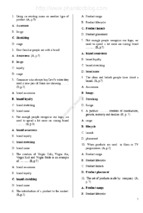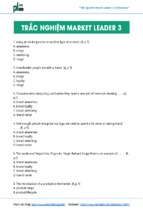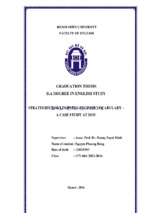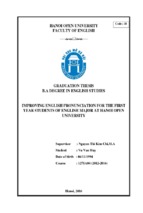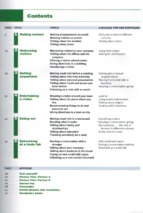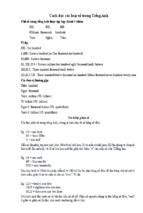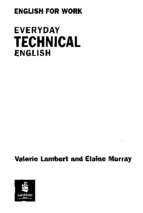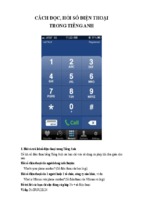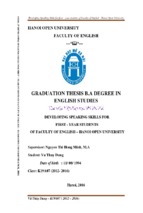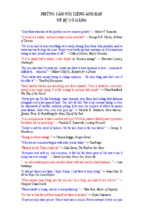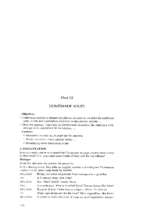2nd edition
v
v
v
v
v
Jane Watson
• Plan and write effective reports
• Create professional letters, memos,
and e-mail
• Enhance the image of your business
B U S I N E S S
S E R I E S
CONTENTS
PREFACE
ix
1 BUSINESS WRITING — THERE HAVE BEEN
SOME CHANGES MADE
Tone
Grammar
Computer software packages
In summary
1
2
3
4
4
2 13 WAYS TO MIND YOUR READER’S BUSINESS
AND PUT YOUR OWN ON THE BACK BURNER
5
3 38 PRACTICAL WRITING TIPS YOU NEVER
LEARNED IN SCHOOL
The reader
Word choice
Sentences
Paragraphs
Appearance
11
12
12
20
24
25
4 26 WAYS TO ADD PERSONALITY TO YOUR
WRITING AND WIN FRIENDS
Different kinds of tone
Starting to write
Being courteous
Selling your message
33
34
37
38
41
V
Thuvientailieu.net.vn
5 42 WAYS TO MASTER LETTERS AND MAKE
YOURSELF LOOK PROFESSIONAL ON PAPER
Organization
Writing
Format
48
48
53
57
6 20 TIPS FOR WRITING SHORT REPORTS AND
MEMOS THAT GET READ AND ACTED UPON
Organization
Writing
Window dressing
82
83
85
91
7 37 WAYS TO TAKE THE STRESS AND DRUDGERY
OUT OF REPORT WRITING AND MAKE YOUR REPORTS READABLE
STEP 1 — Analysis
STEP 2 — Gathering the details
STEP 3 — Organizing the information
Short reports
Formal reports
Graphics
Getting ready to write
STEP 4 — Writing
STEP 5 — Resting
STEP 6 — Editing
96
98
99
100
100
100
106
108
112
115
115
8 38 THINGS YOU NEVER LEARNED IN
KINDERGARTEN — FAXES AND E-MAIL
Faxes
E-mails
117
118
120
9 29 WAYS TO WRITE FOR
THE WORLD WIDE WEB
128
10 44 SUGGESTIONS TO WRITE FASTER, AVOID WRITER’S
BLOCK, COACH OTHER WRITERS,
AND BECOME AN EFFECTIVE GHOSTWRITER
134
Writing faster
134
Avoiding writer’s block
138
Helping others improve their writing
139
Being a ghostwriter
140
VI
BUSINESS WRITING BASICS
Thuvientailieu.net.vn
BIBLIOGRAPHY
142
SAMPLES
1 Hard-to-read-letter
26
2 Easier-to-read-letter
27
3 Format for information letter
51
4 Format for bad-news letter
52
5 Format for persuasion letter
54
6 Information letter (reader name unknown)
61
7 Information letter (block style)
69
8 Information letter (modified block style)
70
9 Information letter (modified semi-block style)
71
10 Bad-news letter (block style)
73
11 Bad-news letter (modified block style)
75
12 Bad-news letter (modified semi-block style)
76
13 Persuasion letter (block style)
77
14 Persuasion letter (modified block style)
78
15 Persuasion letter (modified semi-block style)
80
16 Format for information short report
86
17 Format for problem-solving short report
87
18 Format for persuasion short report
88
19 Format for internal proposal memo
89
20 Information memo with distribution list
93
21 Letter of transmittal
102
22 Report title page
103
23 Executive summary
104
24 Time sheet
111
25 Fax cover sheet
119
CONTENTS
Thuvientailieu.net.vn
VII
WORKSHEETS
1 Planning tool for reader analysis
10
2 Planning tool for letters
49
3 Planning tool for short reports
84
4 Storyboard planning tool for reports
109
5 Time sheet
110
TABLES
1 Easier-to-read words
13
2 Connecting words and phrases
16
3 Clichés to avoid
17
4 Tone
35
5 Formats for writing letters
50
6 Opening lines
55
7 Closing lines
58
8 Formats for writing short reports
85
9 Methods of organizing information reports
107
10 Organization for comparative reports
114
11 Numbering systems for reports
115
CHECKLISTS
1 Business writing style
31
2 Appropriate tone
47
3 Letters
68
4 Short reports and memos
95
5 Editing reports
116
6 E-mails
127
7 Web sites
133
VIII
BUSINESS WRITING BASICS
Thuvientailieu.net.vn
PREFACE
During my school years, I never excelled at putting my thoughts
on paper. True, occasionally I received an “A” and some praise
from a teacher, but for the most part I was content to be an average student in preparing essays and reports.
Then I entered the workforce as an office manager for a government department. Shortly thereafter, the department was
merged with another, and there were several women on staff
much more qualified to run an office than I. My new employer
decided that as I was a university graduate who couldn’t type,
the best place for me would be the writer’s pool. In those days,
writers all had antiquated typewriters on which they would
hunt and peck their stories with two fingers, cut and paste the
material together — with real scissors and glue — and turn it
over to a professional typist to prepare.
I was extremely fortunate. One of the city’s newspapers had
recently folded, and some of the reporters had been hired by the
ministry to write speeches, reports, audio-visual scripts,
brochures, and news releases. I found myself working with four
highly experienced writers who delighted in telling me how to
improve my writing. One of my “editors” was Bill Dodds, who
IX
Thuvientailieu.net.vn
later became a good friend and mentor. Bill never accepted an
“adequate” article, and he forced me to write and rewrite until
I learned to drop the stilted style of the academic world and
write the facts clearly and directly.
After several years under Bill’s wing, I left the government
and stayed home with my young children, teaching part-time at
the local community college. My subjects, of course, were business writing and correspondence and report writing.
As the children grew older, I started my own training and
consulting company in the field of business communications.
For the past decade, I have been a professional speaker in the
field of business communications and have conducted countless
in-house and public workshops in writing skills, written numerous articles on communications, and appeared on radio and
TV. I also provide a one-on-one mentoring program for senior
managers.
One of my favorite quotations is “Find what you enjoy
doing, and you’ll never work a day in your life.” I have been
blessed in discovering what I truly enjoy doing — assisting others to improve their communications skills.
Writing this book was a challenge. It involved collecting and
answering all the questions I have been asked about writing and
putting the answers on paper, as well as relaying the most useful tricks I have learned over the years.
I wanted Business Writing Basics to be three things —
(a) a practical guide for business people, whether they are
working for themselves or someone else,
(b) an up-to-date resource book for today’s marketplace, and
(c) an easy-to-read tool.
For this reason, I organized the material into short points or
rules. Readers can pick up the book, turn to any page, and read
a point that can be immediately incorporated into their normal
business correspondence. All of the points are useful; incorporating even a few into your writing will make a difference.
Best wishes and happy writing!
X
BUSINESS WRITING BASICS
Thuvientailieu.net.vn
Chapter 1
BUSINESS WRITING —
THERE HAVE BEEN SOME
CHANGES MADE
Whenever I conduct a business writing workshop — whether it
is for the general public or for an in-house group — there are always a few people in the audience who are upset by, or strongly
object to, the idea that they should update their writing styles.
When told that effective business writing calls for simple
words matching their readers’ vocabulary level, they complain
that the English language is being “watered down.”
When it is explained that today’s writing should be more direct and less formal than it was a decade ago, they disagree.
Clichés are fine, they claim. After all, the style that suited their
parents and teachers should be good enough today and without
it they won’t appear professional.
However, these people are ignoring the fact that lifestyles,
business practices, and technology have changed: typewriters,
personal secretaries knowledgeable in grammar, shorthand, dictionaries on desks, photocopiers, fax machines, office computers, unit secretaries, personal computers, laptops, spell checkers,
grammar checkers, e-mail, the Internet.
1
Thuvientailieu.net.vn
These are only a few of the resources that had an impact on
writing styles.
From the early 1920s to the 1970s, a manager would dictate
a letter to his or her secretary, who would type it and send it out.
The letter would be written in a verbose style aimed at impressing the reader with the sender’s education and literary style.
And because a third party was involved — the secretary — it
tended to be rather impersonal.
Then, in the early 1980s, we were hit by a recession. North
American business strategies changed and companies became
leaner and more streamlined. Readers wanted their correspondence to match. They no longer wanted to take the time to sort
through wordy, stilted messages and irrelevant details. They
were focused on “the facts, just the facts.”
This demand was further reinforced by the amount of paper
crossing readers’ desks. By 1992, business people received at
least six times as much reading material — letters, reports, faxes
— as they did in 1982. And then to top it off e-mail messages became popular. Today’s readers don’t have the time to absorb convoluted messages. They want to read a message just once and
know precisely what they should do next. Sentences such as
“Kindly execute the attached documents and return them at
your earliest convenience to the undersigned at the above address,” are no longer appropriate. They are too vague and have
the reader’s eyes roving all over the page to pick up the details.
Remember, previously, writers wrote about their interests or
what they wanted the reader to know. However, an experienced
communicator today writes about what the reader needs to know.
TONE
This brings us to tone, or how the message is delivered. In the
past, writers used very formal words and phrases. This was the
normal language of the day. People tended to — and were expected to — speak formally. If you use these same words and
tone in talking with a client or customer today, you are regarded
as old-fashioned and pompous.
2
BUSINESS WRITING BASICS
Thuvientailieu.net.vn
The same is true for your writing. Whether you are communicating internally with staff or externally with customers, you
should write in a friendly, courteous fashion, using the same
words and tone you would use if you were meeting the reader
face to face.
Tell the reader what you can do, rather than what you can’t.
If you are listing features, include benefits. Use the active voice.
Include the reader’s name. And use words that are common to
your normal conversation. For example, I doubt if any human
resources person would ever say, “A prompt reply will expedite
consideration of the student’s application.” If you wouldn’t say
it, don’t write it.
Today, write as though you are speaking — assuming you
speak in a grammatically correct fashion. And that brings us to
the next point: grammar.
GRAMMAR*
Grammar has made a comeback. In the past, many managers
depended on their secretaries to correct their spelling and punctuation errors. However, due to down sizing, right sizing, and
re-engineering, personal secretaries are becoming rare. For the
most part, white-collar workers are now expected to use computers to input, revise, and edit their own correspondence and
reports.
Surprisingly, this hasn’t led to an increase in ungrammatical
writing. Individuals are now paying more attention to their own
correspondence. And more and more executives are requesting
grammar workshops, reference books, or software programs to
improve their accuracy.
One of the best ways you can ensure that your grammar is
correct is to keep a comprehensive, recently published grammar
book handy. (Throw out any books more than five years old.)
*Unfortunately, there is not enough room in this book to include all the important grammar rules as well as the necessary style rules. For an excellent reference book on grammar, I recommend Write Right! by Jan Venolia.
BUSINESS WRITING — THERE HAVE BEEN SOME CHANGES MADE
Thuvientailieu.net.vn
3
Then, read everything that crosses your path with a critical
eye. If a sentence is punctuated in an unusual fashion, don’t accept it as accurate. Check it out.
COMPUTER SOFTWARE PACKAGES
Software packages have been a mixed blessing to business writing. Nowadays you can check spelling, grammar, and readability levels with your computer. However, you can’t rely on
software exclusively. Documents must still be proofread manually as well as electronically because spell checkers don’t always
catch words that are spelled correctly but are misused, such as
its versus it’s and deer instead of dear.
Similarly, they don’t point out all grammar errors, as the
computer cannot determine what you actually meant to say.
They may even draw your attention to punctuation or phrases
that are correct. It is up to you to make the final decision.
In addition, grammar packages can indicate errors, and
readability indexes can point out the difficulty of the reading
level of your documents, but the packages don’t provide enough
information on how to fix the problems they catch. It is up to
you to look up any grammar or style points you don’t understand — check your grammar book or speak with your English
guru. Don’t ignore the problem just because you don’t understand it. The software package has pointed it out for a reason.
IN SUMMARY
Writing is not static. It constantly changes to match the changes
in resources, society, technology, and business. Smart communicators are the ones who recognize that keeping their language
skills on the leading edge means success for themselves and
their organizations.
The following chapters are designed to provide you with
practical guidelines for producing clear, concise letters, memos,
reports, faxes, and e-mail messages that meet the needs of
today’s readers.
4
BUSINESS WRITING BASICS
Thuvientailieu.net.vn
Chapter 2
13 WAYS TO MIND YOUR
READER’S BUSINESS AND
PUT YOUR OWN ON THE BACK
BURNER
One of the main changes in business writing over the recent
years has been in our focus. Even until the late 1970s, senders
wrote about what they knew and what they wanted the reader
to know. Now effective writers “speak” about what the reader
wants to know and needs to know. This change in focus from
the sender’s interests to the receiver’s needs means that writers
must understand their readers before they begin to write.
In one of my workshops, a young man firmly opposed this
idea. He was “much too busy to consider the reader” before he
composed an e-mail message or letter. It was a waste of his
time. Yet this same person also admitted his readers didn’t always follow through the way he wanted. Nor was it unusual for
him to receive phone calls or e-mails requesting additional information, and sometimes he had to write a second letter to
clarify the first. His manager claimed the young man produced
dull, lifeless material that often rambled or irritated readers.
Vague ideas, irrelevant details, missing information, inappropriate tone, boring delivery — these are some of the things
that can detract from your message if you fail to think about
your reader before you write.
5
Thuvientailieu.net.vn
There is a marvelous saying that applies both to report and
correspondence writing: “Typists pound keyboards and writers
stare out windows.” In other words, if you busy yourself on your
keyboard before you are clear about your reader and the reason
for writing, consider yourself a typist. However, if you sit back
and think before you begin to input your ideas, you will be an
effective writer. And if you learn to see through your readers’
eyes, talk their language, and present the message in a manner
that will appeal to them, then your correspondence will develop
an interesting, helpful personality.
Undoubtedly, there are occasions when you don’t know
much about your reader. If you are answering a letter from a
stranger or responding to a quick phone call, you will have to
generalize. But the more you focus on your reader, the better
your correspondence will be.
Here are some questions to ask yourself about your readers
before you begin to write:
1. What is the vocabulary level of your readers? Is English
their main language? Are they comfortable with long,
complicated words, or are simpler words better? In addition, although long-time residents of a country may know
numerous words for an item, new arrivals may know only
one.
2. How much education do the readers have? Do they have a
general education or are they specialists in the same field
as you? Are jargon or “insider” words appropriate?
3. What is the approximate age of the readers? Are they in
the workforce? Although older readers may prefer a more
formal tone, they still may want clear, concise documents.
Many business people are becoming older and reaching the point where they require reading glasses. Ensure
your typeface is a reasonable size.
4. How are you related to the reader? Are you writing to
your boss, the public, a client, a potential customer, the
president of your company, or the board of directors?
6
BUSINESS WRITING BASICS
Thuvientailieu.net.vn
Your tone must change accordingly. Generally, memos or
e-mails to your boss and colleagues are less formal than
letters written to clients.
5. What do your readers do for a living? How much understanding do they have of this particular subject? Conveying information of a legal nature to a lawyer requires
different words than conveying the same information to a
layperson.
6. How many times have you written to these readers about
this topic? Is this the first time, so that background details
are needed? Is this the second, third, or fourth time you’ve
written? If so, reduce or eliminate the background and
concentrate on the current details.
7. What special interests or concerns will the readers have regarding this information? Are you writing a report for
politicians whose constituents are affected by your message? If so, you had better include a strong analysis of the
pros and cons of your message. Are you writing a proposal
to people who believe another company should be the chosen vendor? You will need some strong arguments and
some creative thinking to convince them otherwise.
8. Are there any economic or staff constraints that will be
foremost in the readers’ minds when they read your material? If you are recommending spending money your organization doesn’t have, you may be wasting your time
with this correspondence, or you may have to be particularly persuasive and explain where the money can be
found.
9. What sort of reports do the readers normally want to receive? If you know they prefer reports of no more than two
pages in length, don’t give them a ten-page document. If
you know they want the recommendation at the top of the
first page, that’s where you should put it.
10. If your readers are in a different country, their writing rules
may differ. It is not only courteous but also good business
sense to try to adapt your writing style to theirs.
13 WAYS TO MIND YOUR READER’S BUSINESS...
Thuvientailieu.net.vn
7
The British have a much more formal writing style
and tend to use expressions North Americans consider
outdated. The British consider the North American “natural” tone disrespectful. Japanese writers are extremely polite and begin letters with references to impersonal topics,
such as the weather. Their writing style is indirect, as opposed to the North American desire for clarity and conciseness. In reports, the Japanese tend to present
information in chronological order. German reports include detailed background information whether readers
require it or not. The tradition in France is to begin reports
with the theory behind the problem and follow with the
history. Writers from Latin countries often subscribe to the
theory “more is best,” and include numerous details and
adjectives. They tend to play down bad news.
Stay alert to the different meanings of words. Although English, Spanish, Portuguese, French, and Italian
are all based on Latin, they developed differently. Therefore, some words have a different range of meanings according to the country. For example, the French word for
a teacher is le professeur. However, in English the term
professor is used only for a teacher at a university.
11. What do the readers need to know about this topic in
order to take action? And what do they want to know? As
soon as you have focused on this information, you can
eliminate all other details.
12. How do you want your readers to react to your message?
Do you want them to take some action? In that case, your
request should be concrete, concise, and direct. If the information is bad news, you will want to maintain their
goodwill and future cooperation. This affects the organization of the message.
8
BUSINESS WRITING BASICS
Thuvientailieu.net.vn
Do you want them to feel some emotion? Do you want
them excited about your idea or your product so they’ll
want it, or do you need them to be concerned so they’ll
contribute to your charity? This information alters your
word choice.
13. Are there any secondary readers? Secondary readers are
people to whom a copy of your correspondence is passed.
For example, if your boss is pleased with the report you
have written, he or she may pass it on to a manager. That
manager is your second reader, and the report should be
written and organized in a manner that will meet his or
her needs.
Worksheet 1 is a planning tool for analyzing your reader. If
you use it before you begin to write, you will find that, in the
long run, you will produce reports and correspondence more efficiently. In addition, you will start getting the response you
want from your readers, as you will be writing more clearly, with
the appropriate tone.
13 WAYS TO MIND YOUR READER’S BUSINESS...
Thuvientailieu.net.vn
9
WORKSHEET 1
PLANNING TOOL FOR READER ANALYSIS
PRIMARY READER
Reader’s
background
Relationship
to writer
Vocabulary level
Basic
Standard
Technical
Tone
Informal
Semi-formal
Formal
Pleased
Upset
Information
reader already
has
Details
the reader
needs to know
Details
the reader
wants to know
Reader’s reaction
Action you want
reader to take
Are there any secondary readers?
10
BUSINESS WRITING BASICS
Thuvientailieu.net.vn
Indifferent
Chapter 3
38 PRACTICAL WRITING TIPS
YOU NEVER LEARNED IN
SCHOOL
Although writing ranks as one of the key skills needed in business today, few people have received extensive training in this
area. They have either specialized in courses that require little
writing, such as mathematics, or they have taken courses that
concentrate on academic writing, which is not the same as business writing.
Academic writing differs from business writing primarily in
terms of the reader and the goal. In academic writing, the writer
is trying to convince a limited audience that he or she knows a
great deal about a specific topic. The reader is usually an expert
in the field and is paid to read and critique the document.
In the business world, documents are usually written for
multiple readers who may not be familiar with the subject
matter. Business documents are prepared under time and
money constraints. In addition, the readers don’t have to —
or don’t wish to — take the time to sort through and interpret
long, complicated messages. Therefore, today’s business communications require a style of writing that is concise, clear,
and easy to read.
11
Thuvientailieu.net.vn
This chapter is devoted to specific, easily adopted tips that
ensure your correspondence — whether it travels by “snail
mail” or by electronic methods — meets the needs of the marketplace and projects an image of you as a professional, customer-oriented, clear-thinking individual.
THE READER
1. Knowing your reader is the key to success. The number one rule of all communications — written or spoken
— is to know your audience. Everything hinges on this information. It is so important, I devoted a whole chapter to
it. If you have not yet read chapter 2, I suggest you go back
and do so.
WORD CHOICE
2. Simple words work best. Reading comprehension studies show that people absorb information faster if it is written slightly below their normal comprehension levels. And
if they are in business — whether they are on their own or
working for someone else — they don’t have time to check
a dictionary or ponder the meanings of unfamiliar words.
Although there are over a million words in the English
language, the average adult has a working vocabulary of
only 5,000 words and learns just two new words a year. In
addition, most of the words in the English language have
more than one meaning.
To ensure the average reader interprets your message
correctly, choose short, simple words. This will reduce the
chance for misunderstandings. Table 1 shows a list of words
that have been standard fare in business letters and offers
you some alternative, simpler words to use in their place.
Some readers may ask what will happen to the English
language if we eliminate the fancy words. But polysyllabic
words are still available for creative or recreational writing.
3. Jargon has its place. Jargon is the technical language
used by a specific group or profession. If you’re writing for
such a group, jargon can explain concepts more
12
BUSINESS WRITING BASICS
Thuvientailieu.net.vn
TABLE 1
EASIER-TO-READ WORDS
INSTEAD OF
. . . . . . . . . . . .USE
alleviate . . . . . . . . . . . . . . . . . .lessen, ease
ameliorate . . . . . . . . . . . . . . . .improve
anticipate . . . . . . . . . . . . . . . . .expect
ascertain . . . . . . . . . . . . . . . . .determine, find out
as per your request . . . . . . . . .as you requested
cognizant . . . . . . . . . . . . . . . . .aware
consequence . . . . . . . . . . . . . .result, outcome
despite the fact that . . . . . . . .although
enable . . . . . . . . . . . . . . . . . . .allow, help
endeavor . . . . . . . . . . . . . . . . .try
eventuality . . . . . . . . . . . . . . . .result, outcome
expedite . . . . . . . . . . . . . . . . . .speed up
facilitate . . . . . . . . . . . . . . . . . .help, aid
forward . . . . . . . . . . . . . . . . . .send
immediately . . . . . . . . . . . . . . .now, right away
implement . . . . . . . . . . . . . . . .start
initiate . . . . . . . . . . . . . . . . . . .start, begin
in order to . . . . . . . . . . . . . . . .to
necessitates . . . . . . . . . . . . . . .requires
notwithstanding . . . . . . . . . . .but, despite, regardless
occurrence . . . . . . . . . . . . . . . .event, incident
perusal . . . . . . . . . . . . . . . . . . .review, information
signify . . . . . . . . . . . . . . . . . . .mean
substantiate . . . . . . . . . . . . . . .support, prove
under no circumstances . . . . .never
utilize . . . . . . . . . . . . . . . . . . . .use
variation . . . . . . . . . . . . . . . . .change
whether or not . . . . . . . . . . . .if
38 PRACTICAL WRITING TIPS...
Thuvientailieu.net.vn
13
- Xem thêm -

